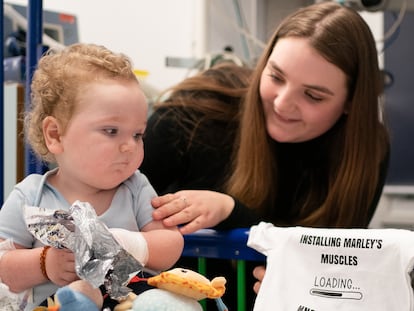Hemophilia: breakthrough therapies aim to ‘dethrone’ the disease of kings
The new and million-dollar gene treatment make the disease remit almost completely for four or five years. Open investigations now seek a definitive cure
A London wedding on February 10, 1840, put hemophilia center stage of an international political drama. Queen Victoria of England married Prince Albert of Saxe-Coburg-Gotha and unwittingly passed on a defective gene to their children that causes a disease that impairs the body’s ability to control bleeding. The couple’s nine children married and spread hemophilia throughout other European monarchies. Despite their royal power, these nobles could do little to combat incapacitating hemorrhages and premature deaths.
Almost two centuries later, in a town near A Coruña (Spain), a security system operator has become one of the first hemophiliacs in the world to experience something for which many monarchs would have given up a crown: a gene therapy that produced complete remission of hemophilia symptoms for more than three years. “It has been a mind-blowing process,” said Iván Torcal.
Torcal remembers the constant fear of his childhood. “I have severe hemophilia. Not only do I hemorrhage from minor bumps and cuts, but they also occur spontaneously in my joints – elbows, knees, ankles... They swell and hurt, and I lose mobility. I have to lead a very careful and planned-out life. I go several times a week to the hospital to get my clotting factor treatment. This is a difficult way to live when you are older – imagine what it’s like for a child. Your parents are on top of you all day long,” he said.
In August 2019, Torcal went to his local public health system hospital (Complejo Hospitalario Universitario de La Coruña) to enroll in a clinical trial. They gave him an intravenous injection of a laboratory-modified virus that transports to the liver a healthy gene with the clotting factors that hemophiliacs lack.
“It was all quite slow and calm,” said Torcal. “They monitored me for a few hours and sent me home once they saw I was fine.” When he woke up the next day, Torcal really was okay. Tests immediately showed very high levels of clotting factors – his liver had started to produce them, just like people without hemophilia. “After a lifetime of being constantly careful, everything changes. You don’t get hurt from a little bump, you can ride a bike without worrying, and your joints no longer hurt. At first, it’s all very strange,” he said.
Torcal suffers from hemophilia A, caused by a congenital deficiency of clotting factor VIII. Almost half of the patients suffering from this type of hemophilia develop a serious or severe form of the disease. Depending on the clotting factor levels in the blood, others will develop moderate or mild forms of the disease and don’t bleed or hemorrhage as easily. According to Spain’s Ministry of Public Health, hemophilia A occurs in six of every 100,000 people in the European Union.
Hemophilia B, caused by a deficit in clotting factor IX, is rarer and causes similar disorders. Spain’s Ministry of Public Health reports that 77 people in the country have been genotyped with severe hemophilia B and 50 with the moderate form. However, the total number of affected people could be around 300. Hemophilia C – the third type of the disease – is less prevalent and generally much milder.
Victor Jiménez Yuste, vice-president of the Spanish Society of Hematology and Hemotherapy (SEHH) and a hematology specialist at La Paz Hospital in Madrid, says hemophilia almost always affects men rather than women. “The gene responsible for hemophilia A and B is on the X chromosome,” said Jiménez. “Women can be carriers since they have two X chromosomes, but won’t develop the disease because they still have one healthy gene. But a female carrier has a 50% chance of passing on the affected chromosome to her children. Since men only have one X chromosome [the other is Y], they will certainly be hemophiliacs if they inherit the gene.”

Dr. Jiménez describes the new gene therapy as a “real revolution. We made more progress in the last few years than in the previous three or four decades. Before, we only had factor VIII or IX replacement treatments with blood derivatives obtained from donors. Then recombinant drugs emerged.” These drugs are synthesized in a laboratory and offer much better patient safety. The blood derivatives used in the past frequently contained viral infections that were passed on to hemophilia patients when injected. Spain’s Hemophilia Federation estimates that 1,000 hemophiliacs died in Spain from HIV and hepatitis C in the last two decades of the 20th century.
Gradual medical advances enabled hemophiliacs to approach the life expectancy of the rest of the population. But their quality of life still suffered. “Patients must go to the hospital several times a week for these intravenous prophylactic drugs,” said Jiménez. People with mild cases can lead more or less normal lives since they only need the clotting factor when they have a wound.” Some patients also develop antibodies to the clotting factor when it’s identified as foreign by their bodies, which worsens the prognosis and complicates treatment.
The approval of Hemlibra (Roche) by Spain’s public health system in 2019 represented a significant qualitative benefit for patients with hemophilia A. Depending on the case, this treatment can be administered with a simple subcutaneous prick weekly, biweekly or monthly. “Gene therapies are the great leap forward we needed,” said Jiménez.
While it was still in clinical trials, Iván Torcal received Roctavian (BioMarin), the first gene therapy approved by the European Medicines Agency (EMA). The drug was authorized for sale by the European Commission for hemophilia A in August 2022. In February 2023, the Commission approved Hemgenix (CSL Behring) for hemophilia B.
Vicente Arocas, a Spanish Society of Hospital Pharmacy (SEFH) drug evaluation group member, said, “These treatments have very high initial efficacy and can elevate factors VIII and IX a great deal, depending on the case. But after six months, the levels start dropping, and we don’t know how long they will be effective. That’s why the EMA has only granted them conditional approval until the pharmaceutical companies provide more data.”
The other big question is patient safety. “The trials and real-life data include very few patients, so we still don’t know the less frequent side effects,” said Arocas. “We do know that they have liver toxicity and that the DNA used can be introduced into other cells in the body, which carries the risk of patients developing some types of cancer.”
Iván Torcal told us that despite the promising results he experienced, he also developed “elevated liver transaminase levels,” forcing him to take corticoids for about 18 months. Transaminases are important in the synthesis of amino acids, which form proteins. “I gained about 10 or 12 kilos with the treatment, which was quite annoying,” said Torcal. Disappointingly, his coagulation factor levels have dropped significantly after three and a half years of Roctavian treatments. He may soon have to return to the old treatments before the gene therapy.
Fernanda López is the head of hematology at the hospital where Torcal was treated. “The coagulation factor levels of the four patients we have treated here dropped greatly since the first year. But they only have mild hemophilia and can lead almost normal lives. In Iván’s case, I’d say he’s back to moderate hemophilia.”
Despite the “gigantic progress” offered by the first gene therapies, López believes there is still potential for improvement. “They can’t be used to treat children right now, nor for liver patients or people with antibodies to the virus used as a vector.”
A dozen other gene therapies are being developed to treat hemophilia A and B and offer the potential of a complete cure or long-term remission. The available data suggest a symptom remission duration of up to 10 years in hemophilia A and 20 years in hemophilia B. However, clinical trial projections often have to be lowered when treatments are approved for use in the real world.
In Spain, treatment coverage by the public health system is still being negotiated as the companies that developed Roctavian (BioMarin) and Hemgenix (CSL Behring) are asking for exorbitant prices. In other countries, Roctavian costs close to $1.6 million (€1.5 million), and Hemgenix costs $3.5 (€3.3 million), making it the most expensive drug in the world.
“These are very innovative treatments and therefore require innovative financing systems,” said FEDHEMO president Daniel-Aníbal García Diego. “One financing method used for other innovative drugs is outcome-based payment. Public health systems pay annually until the treatment ceases to be effective. Remember that the average cost of current hemophilia treatments is nearly $215,000 (€200,000). But an excellent product is useless if healthcare systems can’t afford it.”
Sign up for our weekly newsletter to get more English-language news coverage from EL PAÍS USA Edition
Tu suscripción se está usando en otro dispositivo
¿Quieres añadir otro usuario a tu suscripción?
Si continúas leyendo en este dispositivo, no se podrá leer en el otro.
FlechaTu suscripción se está usando en otro dispositivo y solo puedes acceder a EL PAÍS desde un dispositivo a la vez.
Si quieres compartir tu cuenta, cambia tu suscripción a la modalidad Premium, así podrás añadir otro usuario. Cada uno accederá con su propia cuenta de email, lo que os permitirá personalizar vuestra experiencia en EL PAÍS.
¿Tienes una suscripción de empresa? Accede aquí para contratar más cuentas.
En el caso de no saber quién está usando tu cuenta, te recomendamos cambiar tu contraseña aquí.
Si decides continuar compartiendo tu cuenta, este mensaje se mostrará en tu dispositivo y en el de la otra persona que está usando tu cuenta de forma indefinida, afectando a tu experiencia de lectura. Puedes consultar aquí los términos y condiciones de la suscripción digital.
More information
Últimas noticias
Most viewed
- Sinaloa Cartel war is taking its toll on Los Chapitos
- Oona Chaplin: ‘I told James Cameron that I was living in a treehouse and starting a permaculture project with a friend’
- Reinhard Genzel, Nobel laureate in physics: ‘One-minute videos will never give you the truth’
- Why the price of coffee has skyrocketed: from Brazilian plantations to specialty coffee houses
- Silver prices are going crazy: This is what’s fueling the rally











































